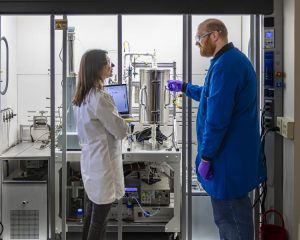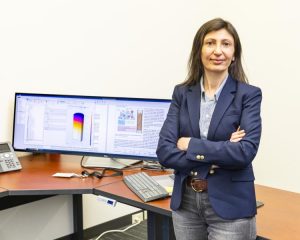March 25, 2024 — Canan Karakaya decided to become a chemical engineer during a college field trip to a fertilizer plant.

When ammonia gas reacted with nitric acid, she watched its transformation into ammonium nitrate as it flowed down a huge column. Questions filled her head as she watched white flakes, which had just been a liquid, float gently through the air. “It was so beautiful and unexpected,” she said. “Fertilizer doesn’t come to mind as beautiful white snow. I wanted to know how they make it, and how did they create this facility?”
That curiosity and enthusiasm for the beauty in every molecule inspired Karakaya to become a chemical engineer, then a chemist, then a mechanical engineer before putting all those skills to work at the Department of Energy’s Oak Ridge National Laboratory (ORNL). “I’m a curious person by nature. I really want to know how things happen, why, and whether we can change it if we don’t like it,” Karakaya said. “I think everything starts with that curiosity – I want to understand molecules, reactors, chemicals and people.”
At ORNL, Karakaya specializes in computational modeling to design and improve chemical reactors and the way they’re operated. These reactors convert methane, carbon dioxide, ammonia or ethanol into higher-value chemicals or energy-dense fuels.
A member of the Chemical Process Scale-up group in the lab’s Energy Science and Technology Directorate, Karakaya offers unusually broad expertise in applied chemistry and engineering. “My research really brings two scales together: atomic scale and reactor scale,” Karakaya said. She can model from the atomic scale all the way to a fully operating commercial process.
“I like engineering because you are designing a system to be perfect,” Karakaya added. “I can tell you why it works, how to optimize it and whether a challenge can be solved by changing the system or its operating conditions.”
‘Where the creativity comes in’
Karakaya’s earliest memory of a childhood science experiment is a classic: She tossed objects in a creek to see what sinks or floats. “I was always up a tree or under the ground,” she said, exploring the natural caves near her Turkish hometown and chasing her two older brothers. She couldn’t resist looking deep into natural things like tiny flowers and insect exoskeletons. “I used broken glass for my microscope,” she said. “That’s where the creativity comes in.”

Her mother encouraged her independence, modeling it at home by handling plumbing and repair jobs, building mechanical wooden toys for the kids and ignoring relatives who expressed disapproval as her lively daughter splashed through mud instead of playing with dolls.
“I was able to really be in nature and understand how nature works,” Karakaya said. “What we do at the national lab is not far from that: understanding how nature works, and how we can and can’t manipulate that.”
As she grew up, her fascination with tiny natural systems led Karakaya to molecules, and eventually to pursuing undergraduate and master’s degrees in chemical engineering from Kocaeli University. Then, Olaf Deutschmann, an internationally recognized expert in computational modeling for low-emissions energy conversion, invited her to be his doctoral student at the Karlsruhe Institute of Technology in Germany. She boarded a train with one suitcase, beginning a life of following scientific opportunities. Karakaya says she feels at home wherever they are.
At first, Karakaya pursued experimental projects in the laboratory. “I built a reactor bigger than me, then I got to run it,” she said. But when it was time to hand her data to a modeler, she realized she wanted to be involved in that step, too.
“I found myself deep into the modeling. It’s beautiful,” Karakaya said. “It comes back to my childhood curiosity because you really understand why and how the system works. You’re projecting a light into this black box of a reactor. Now you can see the molecules in action.”
Her doctoral research involved developing computational models and optimizing conversion technology for syngas, which is a fuel that can also be used to make synthetic fuels, ammonia or methanol. The health care and agriculture company Bayer bought her model, then used it to build a pilot-scale reactor. “That was my initial trigger to say, ‘Oh! This has a meaning in the real world,’” Karakaya said. “I think I’ve been chasing that rush ever since.”
Karakaya continued collaborating with industrial partners as a research assistant professor at Colorado School of Mines under prominent mechanical engineer Robert J. Kee. Her role combined coding, reactor modeling and improving pathways to create energy-dense fuels or commodity chemicals.
There, her research also came full circle to the wonder of the fertilizer snow. “I was able to model an ammonia system. It was beautiful,” she said. “Ammonia research for me is a little bit special, because it was my first love.”
Overcoming engineering challenges for climate, industry
Karakaya packed her suitcase again three years ago to join the research team at ORNL. One of her first projects involved identifying a heat transfer problem in a pilot reactor owned by Pyran, a company that makes bio-based substitutes for petroleum-based chemicals. She and her colleague Bruce
Adkins helped Pyran design pilot-scale reactors using the lab-scale data.

“I often look at systems from nature’s pathway,” Karakaya said, jumping up and heading to her white board. “Look at this! I’m going to show you something really beautiful.” She jotted a chemical reaction for a ring opening of a cyclic alcohol reaction. “Thermodynamic analysis tells you what you cannot make. This helps me explain the limiting parameters and identify the challenges in the process.”
For Missouri-based industrial partner Catalyxx Inc., Karakaya and Adkins modeled the scale-up of a reactor for converting ethanol to butanol, an intermediate chemical that can be used to make other chemical products or as a fuel additive. The ORNL team provided a recipe for maximizing production while reducing unwanted byproducts.
“Canan and Bruce helped us simulate different pressures and temperatures in the reactor, so we were able to bring in new ideas about how to improve the process,” said Joaquin Alarcon, Catalyxx president and chief executive officer. “Canan was very enthusiastic.” Alarcon’s company took the reactor from pilot to demonstration phase and is currently pursuing a commercial plant.
Besides working with industry, Karakaya is motivated by the opportunity to fight climate change through her group’s research into carbon dioxide conversion. They are channeling carbon dioxide into chemical reactions that create valuable products and are exploring engineering reactions to produce less carbon dioxide.
Today, Karakaya is leading the projects to transform carbon dioxide into products such as ethylene, methanol and methane while also supporting research on formation of formic acid or dimethyl ether. Ethylene is the building block of the synthetic fuels or polymers, and dimethyl ether can be used as a fuel or an intermediate step to making cleaner-burning diesel or gasoline. She is also supporting projects for converting ethanol to sustainable aviation fuels that offer high energy density while producing less carbon dioxide.
Karakaya was attracted to working at ORNL because she could help companies tackle specific problems and also develop broader conversion capabilities from the ground up. “The beauty of the national lab is that I can really be a witness of this technology growing, and at every step, I can be a part of it,” she said.
Source: ORNL

























































